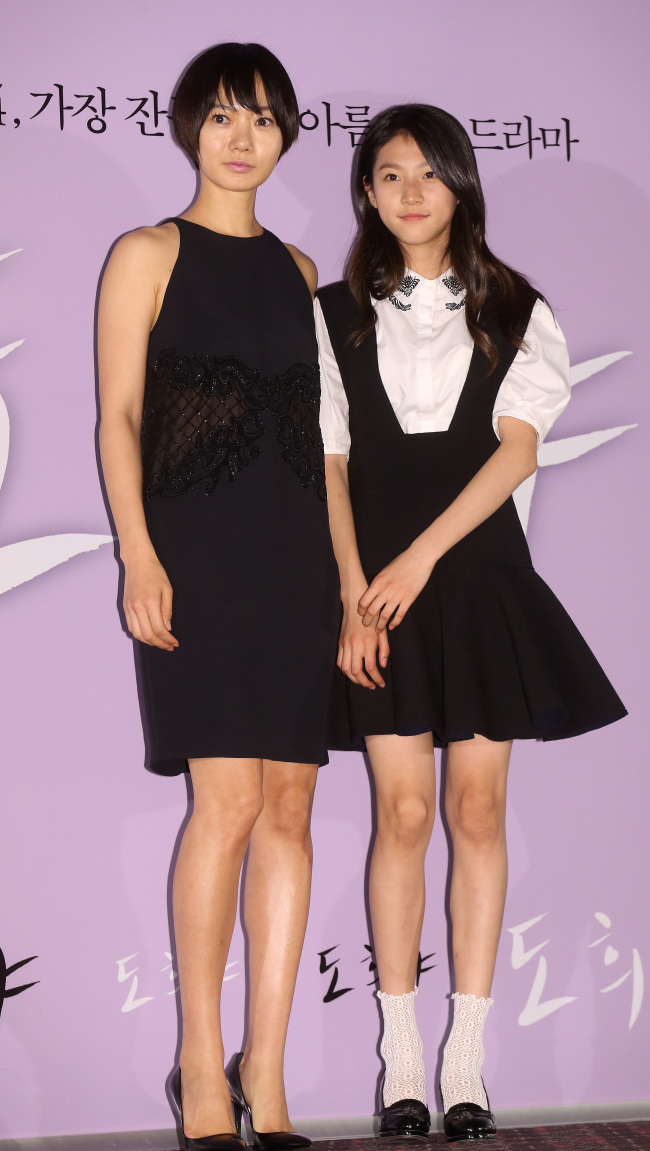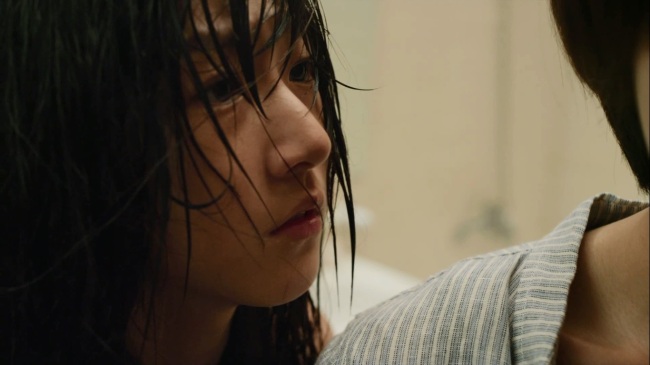[Herald Review] ‘A Girl at My Door’ powerful, resonating study of the alienated
Filmmaker July Jung goes to Cannes with her debut feature
By Korea HeraldPublished : May 13, 2014 - 20:39

In a quiet, seemingly uneventful Korean port town, Young-nam (Bae Doo-na), a young woman with a pale face, arrives as the head of its police substation ― after being demoted from Seoul. All of her subordinates in the station are men, most of whom are older than she. On her way to her new house in the village, she runs into Yong-ha (Song Sae-byeok), “the man who runs the economy of the town,” who smiles derisively after learning that Young-nam is the new chief officer.
Filmmaker July Jung’s feature debut “A Girl at My Door,” which has been invited to the Un Certain Regard section of this year’s Cannes International Film Festival, was unveiled to the local press on Monday.
“I guess one of the reasons why I wrote this story was because I was lonely myself,” filmmaker Jung told reporters. “I wanted to tell a story about lonely people, and how they can comfort each other ― and explore if that is actually possible.”
And her film does just that. Young-nam, though seemingly content, is in fact deeply troubled. She cannot sleep without the help of soju, so she keeps the transparent liquor in countless water bottles ― making it look as if what she is consuming every day is water.
Filmmaker July Jung’s feature debut “A Girl at My Door,” which has been invited to the Un Certain Regard section of this year’s Cannes International Film Festival, was unveiled to the local press on Monday.
“I guess one of the reasons why I wrote this story was because I was lonely myself,” filmmaker Jung told reporters. “I wanted to tell a story about lonely people, and how they can comfort each other ― and explore if that is actually possible.”
And her film does just that. Young-nam, though seemingly content, is in fact deeply troubled. She cannot sleep without the help of soju, so she keeps the transparent liquor in countless water bottles ― making it look as if what she is consuming every day is water.

The peaceful rural town very soon reveals its brutal and violent side when Young-nam runs into Do-hee (Kim Sae-ron), Yong-ha’s teenage stepdaughter who is exposed to constant physical abuse. She also learns that Yong-ha helps local fisheries hire undocumented immigrants, many of whom are underpaid or not paid at all. Most of the locals, however, keep silent about the injustices that Do-hee and the migrant workers endure, as Yong-ha helps them make money. The village is mostly populated by aging natives, as their children all leave for cities once grown.
The film pays most attention to Young-nam’s relationship with Do-hee, who, in director Jung’s words, “doesn’t even realize she is lonely.” The teenager is constantly beaten by her stepfather and her grandmother, and also bullied by her classmates at school. Concerned for Do-hee’s safety, Young-nam keeps the teenager at her house. For the first time in her life, Do-hee meets someone who does not beat her and who actually calls her by her name ― the Korean title of the film is “Doheeya,” which translates to “Hey Do-hee” ― instead swearing at her. But Do-hee’s happy period abruptly ends when Yong-ha finds out Young-nam’s secrets, which are linked to why she was demoted back in Seoul, and uses them against her.
Aside from its main plot, which deftly blends mystery and thriller, the film does an impressive job of tackling modern Korean social issues, including homosexuality, small-town politics, migration and labor. What’s most resonating, arguably, is Young-nam’s first encounters with Do-hee and the migrant workers, and her look of vulnerability when she witnesses the injustice; in spite of her authority, Young-nam, who is forced to keep one of her identities a secret, knows she shares more in common with the abused than her fellow officers. In spite of her isolation, which even leads her to alcoholism, her integrity does not allow her to compromise in order to fit in. The three lead actors, especially Bae, offer memorable performances as troubled, lonely and searching souls.
By Claire Lee (dyc@heraldcorp.com)
-
Articles by Korea Herald



![[AtoZ into Korean mind] Humor in Korea: Navigating the line between what's funny and not](http://res.heraldm.com/phpwas/restmb_idxmake.php?idx=644&simg=/content/image/2024/04/22/20240422050642_0.jpg&u=)

![[Exclusive] Korean military set to ban iPhones over 'security' concerns](http://res.heraldm.com/phpwas/restmb_idxmake.php?idx=644&simg=/content/image/2024/04/23/20240423050599_0.jpg&u=20240423183955)

![[Herald Interview] Why Toss invited hackers to penetrate its system](http://res.heraldm.com/phpwas/restmb_idxmake.php?idx=644&simg=/content/image/2024/04/22/20240422050569_0.jpg&u=20240422150649)
![[Graphic News] 77% of young Koreans still financially dependent](http://res.heraldm.com/phpwas/restmb_idxmake.php?idx=644&simg=/content/image/2024/04/22/20240422050762_0.gif&u=)







![[Exclusive] Korean military to ban iPhones over security issues](http://res.heraldm.com/phpwas/restmb_idxmake.php?idx=652&simg=/content/image/2024/04/23/20240423050599_0.jpg&u=20240423183955)



![[Today’s K-pop] Ateez confirms US tour details](http://res.heraldm.com/phpwas/restmb_idxmake.php?idx=642&simg=/content/image/2024/04/23/20240423050700_0.jpg&u=)